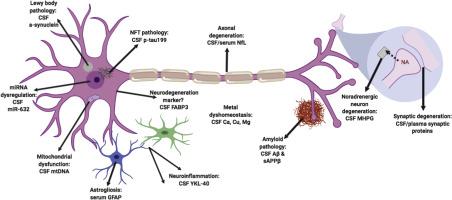当前位置:
X-MOL 学术
›
J. Neurol. Sci.
›
论文详情
Our official English website, www.x-mol.net, welcomes your feedback! (Note: you will need to create a separate account there.)
Novel fluid biomarkers to differentiate frontotemporal dementia and dementia with Lewy bodies from Alzheimer's disease: A systematic review
Journal of the Neurological Sciences ( IF 4.4 ) Pub Date : 2020-08-01 , DOI: 10.1016/j.jns.2020.116886 Aiysha Chaudhry 1 , Henry Houlden 1 , Mie Rizig 1
Journal of the Neurological Sciences ( IF 4.4 ) Pub Date : 2020-08-01 , DOI: 10.1016/j.jns.2020.116886 Aiysha Chaudhry 1 , Henry Houlden 1 , Mie Rizig 1
Affiliation

|
RATIONALE
Frontotemporal dementia (FTD) and dementia with Lewy bodies (DLB) are two common forms of neurodegenerative dementia, subsequent to Alzheimer's disease (AD). AD is the only dementia that includes clinically validated cerebrospinal fluid (CSF) biomarkers in the diagnostic criteria. FTD and DLB often overlap with AD in their clinical and pathological features, making it challenging to differentiate between these conditions. AIM
This systematic review aimed to identify if novel fluid biomarkers are useful in differentiating FTD and DLB from AD. Increasing the certainty of the differentiation between dementia subtypes would be advantageous clinically and in research. METHODS
PubMed and Scopus were searched for studies that quantified and assessed diagnostic accuracy of novel fluid biomarkers in clinically diagnosed patients with FTD or DLB, in comparison to patients with AD. Meta-analyses were performed on biomarkers that were quantified in 3 studies or more. RESULTS
The search strategy yielded 614 results, from which, 27 studies were included. When comparing bio-fluid levels in AD and FTD patients, neurofilament light chain (NfL) level was often higher in FTD, whilst brain soluble amyloid precursor protein β (sAPPβ) was higher in patients with AD. When comparing bio-fluid levels in AD and DLB patients, α-synuclein ensued heterogeneous findings, while the noradrenaline metabolite (MHPG) was found to be lower in DLB. Ratios of Aβ42/Aβ38 and Aβ42/Aβ40 were lower in AD than FTD and DLB and offered better diagnostic accuracy than raw amyloid-β (Aβ) concentrations. CONCLUSIONS
Several promising novel biomarkers were highlighted in this review. Combinations of fluid biomarkers were more often useful than individual biomarkers in distinguishing subtypes of dementia. Considering the heterogeneity in methods and results between the studies, further validation, ideally with longitudinal prospective designs with large sample sizes and unified protocols, are fundamental before conclusions can be finalised.
中文翻译:

区分额颞叶痴呆和路易体痴呆与阿尔茨海默病的新型液体生物标志物:系统评价
基本原理 额颞叶痴呆 (FTD) 和路易体痴呆 (DLB) 是继阿尔茨海默病 (AD) 之后神经退行性痴呆的两种常见形式。AD 是唯一一种在诊断标准中包含经临床验证的脑脊液 (CSF) 生物标志物的痴呆症。FTD 和 DLB 的临床和病理特征通常与 AD 重叠,这使得区分这些疾病具有挑战性。目的 本系统评价旨在确定新的体液生物标志物是否可用于区分 FTD 和 DLB 与 AD。提高痴呆亚型之间区分的确定性在临床和研究中都是有利的。方法 在 PubMed 和 Scopus 中搜索量化和评估临床诊断的 FTD 或 DLB 患者与 AD 患者相比的新型液体生物标志物诊断准确性的研究。对在 3 项或更多研究中量化的生物标志物进行了荟萃分析。结果 检索策略产生了 614 条结果,其中包括 27 项研究。当比较 AD 和 FTD 患者的生物体液水平时,FTD 中的神经丝轻链 (NfL) 水平通常较高,而 AD 患者的脑可溶性淀粉样前体蛋白 β (sAPPβ) 水平较高。在比较 AD 和 DLB 患者的生物体液水平时,α-突触核蛋白随后出现异质性发现,而去甲肾上腺素代谢物 (MHPG) 在 DLB 中较低。AD 中 Aβ42/Aβ38 和 Aβ42/Aβ40 的比率低于 FTD 和 DLB,并且提供比原始淀粉样蛋白 β (Aβ) 浓度更好的诊断准确性。结论 本综述强调了几种有前景的新型生物标志物。在区分痴呆亚型方面,液体生物标志物的组合通常比单个生物标志物更有用。考虑到研究之间方法和结果的异质性,在最终确定结论之前,进一步验证,理想情况下采用具有大样本量和统一方案的纵向前瞻性设计是基础。
更新日期:2020-08-01
中文翻译:

区分额颞叶痴呆和路易体痴呆与阿尔茨海默病的新型液体生物标志物:系统评价
基本原理 额颞叶痴呆 (FTD) 和路易体痴呆 (DLB) 是继阿尔茨海默病 (AD) 之后神经退行性痴呆的两种常见形式。AD 是唯一一种在诊断标准中包含经临床验证的脑脊液 (CSF) 生物标志物的痴呆症。FTD 和 DLB 的临床和病理特征通常与 AD 重叠,这使得区分这些疾病具有挑战性。目的 本系统评价旨在确定新的体液生物标志物是否可用于区分 FTD 和 DLB 与 AD。提高痴呆亚型之间区分的确定性在临床和研究中都是有利的。方法 在 PubMed 和 Scopus 中搜索量化和评估临床诊断的 FTD 或 DLB 患者与 AD 患者相比的新型液体生物标志物诊断准确性的研究。对在 3 项或更多研究中量化的生物标志物进行了荟萃分析。结果 检索策略产生了 614 条结果,其中包括 27 项研究。当比较 AD 和 FTD 患者的生物体液水平时,FTD 中的神经丝轻链 (NfL) 水平通常较高,而 AD 患者的脑可溶性淀粉样前体蛋白 β (sAPPβ) 水平较高。在比较 AD 和 DLB 患者的生物体液水平时,α-突触核蛋白随后出现异质性发现,而去甲肾上腺素代谢物 (MHPG) 在 DLB 中较低。AD 中 Aβ42/Aβ38 和 Aβ42/Aβ40 的比率低于 FTD 和 DLB,并且提供比原始淀粉样蛋白 β (Aβ) 浓度更好的诊断准确性。结论 本综述强调了几种有前景的新型生物标志物。在区分痴呆亚型方面,液体生物标志物的组合通常比单个生物标志物更有用。考虑到研究之间方法和结果的异质性,在最终确定结论之前,进一步验证,理想情况下采用具有大样本量和统一方案的纵向前瞻性设计是基础。


























 京公网安备 11010802027423号
京公网安备 11010802027423号